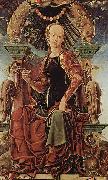Wholesale Oil Painting No Minimum |
|||||||||||
|
|
|||||||||||

|
|||||||||||
|
|
|
||||||||
Cosme TuraItalian Early Renaissance Painter, ca.1430-1495 Italian Renaissance artist. He was a leading master of the school of Ferrara and court painter to the city's ruling Este family. Often vividly emotional, Tura's figures range from the graceful to the grotesque, as in the gentle Mary and contorted Jesus of his c.1472 Pieta (Correr Museum, Venice). Combining material splendor with asceticism, his stylistically idiosyncratic paintings are frequently filled with sharply portrayed natural details??diversified landscapes, squirrels, monkeys, fruits, etc.??that serve as both plastic and iconographic elements. His works are executed in a harsh, nervously linear, and rather angular style, with bold and sometimes strident coloring. Examples of his art include two organ panels, Annunciation and St. George Slaying the Dragon (cathedral, Ferrara); Christ on the Cross (Milan); St. Jerome (National Gall., London); Portrait of a Man and Saints (National Gall. of Art, Washington, D.C.). Attributed to him is a portrait of a member of the Este family, The Flight into Egypt, and St. Louis of Toulouse |
||||||||
|
|
||||||||
Der Fruhling
Der Fruhling Painting ID:: 75434 |
c. 1460
Oil on panel
116 X 71 cm
cjr c. 1460 Oil on panel 116 X 71 cm cjr |
|||||||
|
|
||||||||
|
Cosimo Tura 1430-95 Italian Cosimo Tura Galleries Cosimo Tura (c. 1430 ?C 1495), also known as Il Cosm?? or Cosme Tura, was an Italian early-Renaissance (or Quattrocento) painter and considered one of the founders of the School of Ferrara. Born in Ferrara, he was a student of Francesco Squarcione of Padua. Later he obtained patronage from both Dukes Borso and Ercole I d'Este. By 1460, he was stipended by the Ferrarese Court. His pupils include Francesco del Cossa and Francesco Bianchi. He appears influenced by Mantegna's and Piero della Francesca's quattrocento styles. In Ferrara, he is well represented by frescoes in the Palazzo Schifanoia (1469?C71) . This pleasure palace, with facade and architecture of little note, belonged to the d'Este family and is located just outside the medieval town walls. Cosimo, along with Francesco del Cossa, helped produce an intricately conceived allegorical series about the months of the year and zodiac symbols. The series contains contemporary portraits of musicians, laborers, and carnival floats in idyllic parades. As in Piero della Francesca's world, the unemotive figures mill in classical serenity. He also painted the organ doors for the Duomo showing the Annunciation (1469). He collaborated in the painting of a series of "muses" for a studiolo of Leonello d'Este, including the allegorical figure of Calliope at the National Gallery (see image). While the individual attributions are often debated, among the artists thought to complete the Angelo di Pietro da Sienna, also called Maccagino or Angelo Parrasio, and Michele Pannonio. Der Fruhling Date Deutsch: um 1460 English: c. 1460 Medium Oil on panel Dimensions Deutsch: 116 ?? 71 cm cyf |
||||||||
|
|
||||||||
|
Prev Next
|
||||||||
|
|
||||||||
|
Related Paintings to Cosimo Tura :. |
||||||||
|
|
||||||||
|
CONTACT US |

